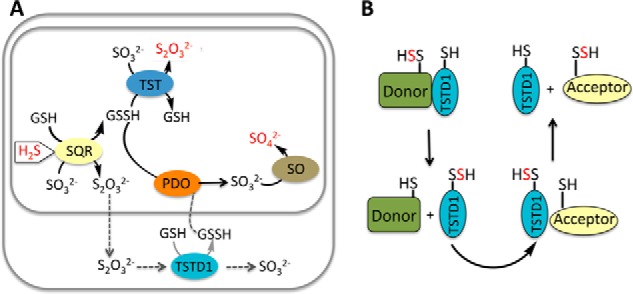Figure 10.

Alternative proposed roles for TSTD1. A, in one model of the mitochondrial sulfide oxidation pathway denoted by gray arrows, the product of sulfide quinone oxidoreductase (SQR) is thiosulfate (S2O32−), which is further processed in the cytoplasm by TSTD1. The product of this reaction is GSSH, which must go across the mitochondrial membranes to be completely oxidized to sulfate. This pathway is considered to be unlikely because the major product of the SQR reaction at physiologically relevant sulfite and glutathione concentrations is predicted to be GSSH. In the mitochondrially contained sulfide oxidation pathway, H2S is progressively oxidized by SQR, persulfide dioxygenase (PDO), TST, and sulfite oxidase (SO) to give thiosulfate and sulfate, which are the major products of H2S oxidation. The input (H2S) and outputs (S2O32−, SO42−) of the sulfide oxidation pathway are highlighted in red. B, based on the structure of TSTD1 and its ability to transfer sulfane sulfur to thioredoxin, we propose that TSTD1 functions in sulfur relay shuttles between donor and acceptor proteins. Alternatively, thioredoxin could potentially function as a persulfide donor and TSTD1 as an intermediary carrier for sulfane sulfur donation to acceptors.
